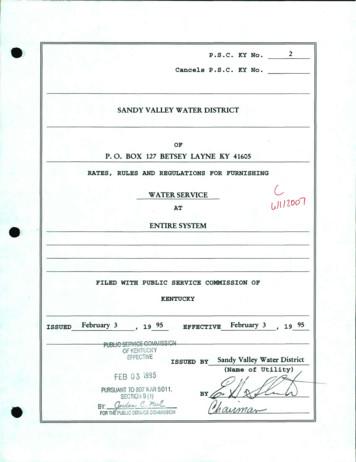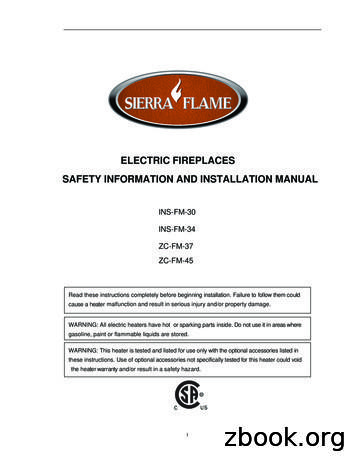Do Now: Page 67 #1-2
Do Now:Page 67 #1-21
Do Now:Page 67 #1-22
Module C Unit 2:Relationships in Ecosystems3
Lesson 1: Parts of an Ecosystem4
Living organisms interact withand are dependent on theirenvironment and oneach other5
Exploration 1:Analyzing the Parts ofan Ecosystem6
Ecological OrganizationEcosystem- includescommunity (all the livingthings) and the physicalenvironment interactingand functioning together.Examples: desert orforest7
8
Example: Forest EcosystemLivingNonliving9
Example: Forest EcosystemLivingNonlivingTREES, MOSSES,LIZARDS, FISH,TURTLE, FLYING SQUIRREL,OWL, FUNGI10
An Ecosystem is.made of biotic and abiotic factors andis self-sustaining if it has a constantsource of energy and cycling ofmaterials.11
12
Biotic FactorsThe parts of anecosystem that areliving, or that resultfrom the activities ofliving things, arecalled biotic factors.13
Abiotic FactorsAll of the non-livingfactors that affect theenvironment.Ex. temperature, intensity oflight, amount of moisture,soil, supply of gases inatmosphere, pH.14
15
Exploration 2:Describing EcosystemStructure16
Levels ofOrganization inEcosystems17
Do Now:Review Levels ofOrganizationPage 73 # 718
Do Now:Review Levels ofOrganizationPage 73 #7-8TISSUEORGANORGAN SYSTEMORGANISM19
20
21
Ecological Organization1. Individual - one organism that canmate and produce fertile offspring.Example: One bunny.22
Ecological Organization2. Population - includes all themembers of the same species that livein a particular area.Example: a group ofbunnies living in a field.23
Ecological Organization (Population)Species- includes all organisms of thesame kind that can mate and producefertile offspring.24
Ecological Organization3. Community - includes all the livingorganism, both plant and animal, livingin a given area.Example: a lawn has populations ofdandelions, grasses, earthworms, andmany other living organisms.25
Ecological Community26
Ecological Community27
Ecological Organization4. Ecosystem- includescommunity (all the livingthings) and the physicalenvironment interacting andfunctioning together.Examples: balancedaquariums orforests.28
29
Lesson 2: Resource Availability inEcosystems30
Exploration 1:Relating ResourceAvailability toGrowth31
Growth Requires Resources All living things must get resources from theirenvironment so that their cells have a source ofmaterials and energy. The resources that organisms need to live and growinclude food, water, and shelter. Organisms get all of the living and nonliving resourcesthey need from the ecosystem in which they live.32
Individual Growth A hatchlingfrom a tiny eggcan become asea turtle.33
Population Growth The growth of a population also depends on theavailability of resources.34
Factors that Influence Resource Availability Population Size Competition Environmental Factors How could weather affect resource availability? What other environmental factors can you think of?35
36
Exploration 2:Predicting Effectsof LimitedResources37
Limited Resources Resources in an ecosystem are often limited,so individuals must compete for the existingresources to meet their needs. Competition occurs when two or moreindividuals or populations try to use thesame limited resource.38
Limited Abiotic Resources Abiotic factors are the nonliving parts of anecosystem Examples: air, water, nutrients, soil,sunlight, and rainfall.39
Exploration 3:Predicting Effectsof AbundantResources40
Abundant Resources Some resources are abundant in certainecosystems. Examples: algal blooms caused bynutrient abundance41
Abundant Biotic and Abiotic Resources An abundance of abiotic or biotic resourcescan result in the growth of individuals andpopulations.42
Lesson 3:Patterns ofInteraction43
Exploration 1:Analyzing FeedingRelationships44
Organism Interaction Predator / Prey relationships: Predators: kill and eat other organisms Prey: are killed for food As predators kill and eat prey the prey populationdecreases. If the prey population decreases, predators starve andtheir numbers decrease. When the predators start todecrease there is less pressure on the prey populationand it starts to increase again.45
Aim: What are some relationships amongorganisms?46
Nutritional Relationships Involved the transfer of energy from oneorganism to another within an ecosystem1. Autotrophic nutrition (producers): able tomake their own food (plants) 2. Heterotrophic nutrition (consumers):depends on others for its nutrition.47
Nutritional Relationships a) Decomposers: fungi, bacteria – theserecycle the dead material back into thefood web.b) Herbivores: animals that eat plants.48
Decomposers49
Herbivores50
Nutritional Relationshipsc) Carnivores: animals that eat animals: theyinclude: Predators: kill and eat other animalsexample: lions Scavengers: eat DEAD organisms, example:vultures, crabs, hyenas51
Carnivores52
Nutritional Relationshipsd) Omnivores: animals that eat bothanimals and plants. Example: humans, bears53
Omnivores54
Exploration 2:ExplainingSymbioticRelationships55
Symbiotic RelationshipsDifferentorganisms livingtogether in a closeassociation(dependency.)56
Symbiotic Relationships1. Commensalism:2. ( , 0) One organism obtains a benefit from therelationship and the other does not benefit or getharmed.a. Example: remora fish and shark, barnacle and whale57
Commensalism58
Symbiotic Relationships2. Mutualism:( , ) Both organisms benefit.Example:a) Lichen (combination of algae and fungus)b) Nitrogen-fixing bacteria in the roots of legumesc) Protozoa in the digestive tract of termites.59
Mutualism60
Symbiotic Relationships3. Parasitism:( , -) one organism (parasite) benefits at the expense(harms) of the other organism (host).Examples:a) Athlete’s foot: fungus and humansb) Tapeworms and certain animals61
Parisitism62
Ecological Organization 3. Community - includes all the living organism, both plant and animal, living in a given area. Example: a lawn has populations of dandelions,
ef-fec1we issued by sandy valley water district ,-eb ri 7 '. ovh :- vi) hjj\j (name by -@- index page 1. page 2. page 3. page 4. page 5. page 6. page 7. page 8. page 9. page 10. page 1 1. page 12. page 13. page 14. page 15. page 16. page 17. page 18. page 19. page 20. .
The Lenape / English Dictionary Table of Contents A page 2 B page 10 C page 10 D page 11 E page 11 F no Lenape words that begin with F G page 14 H page 19 I page 20 J page 20 K page 21 L page 24 M page 28 N page 36 O page 43 P page 43 Q page 51 R no Lenape words that begin with R S page 51 T
Cahier pédagogique À deux roues, la vie! DynamO Théâtre 2 page 3 page 3 page 3 page 4 page 4 page 5 page 5 page 5 page 6 page 7 page 8 page 9 page 10 page 11 page 12 page 12
ÌSprue Bushing MSB-A3530 Page 18 Page 18 Page 18 Page 19 Page 19 Page 19 Page 20 Page 20 Page 20 Page 21 Page 21 Page 21 Page 22 Page 22 Page 22 Page 23 MSB-B3030 MSB-C2520 MSB-D3030 MSB-E2520 MSB-F1530 MSB-G3520 MSB-H3530 . HOT CHAMBER S L GP GB GPO EP C SB SP CL ML MAIN PRODUCTS ITEM
Trouble Shooting Safety Information INS-FM-30 . Remoter Control Operation Page 2 4 Page 5 6 Page 7 Page 8 Page 9 Page 10 Page 10 Page 11 Page 12 Page 13 Page 14 Page 15 Page 16 18 Page 17 1 Warranty Service History Dealer Contact Information Page 20 .
Page 2 Econo-Form Overview Page 3 General Assembly Page 4 Panels Page 5 Channels & Fillers Page 6 Tube & Fittings Page 8 Corners Page 9 Push-Pull Props Page 10 Flex-Forms Page 11 Ties - Ferrule Type Page 12 Ties - Form Type Page 13 Ties - Dywidag Type Page 14 Ties - Water-Bar Type Page 15 Ties - Coil Type Page 17 Extractors Page 18 Climbing
Page 9 TM 886 TM 817 Page 9 TM 877 Page 9 TM 995 Page 9 TM 916 TM 937 TM 972 Page 12 TM 1300 — 1-3/4" Page 8 TM 1305 — 1-3/8" Rb3 Page 16 Rb4 CORneR b OCkS Page 19 wIndOw STOOl Page 7 R 6 Page 16 InTeRIOR JaMbS exTeRIOR JaMbS Page 18 TM 400 Page 8, 12 RadIuS CORneRS Page 19 PyRaMId CORneR blOCkS Page 19 TM 413 Page 12 TM
Set Manual Control Output and Brake Light Switches Initial Setup Test Drive & Adjustment Bench Test Troubleshooting Guide page 2 page 2 page 3 page 3 page 4 page 5 page 6 page 7 page 7 page 8 page 11 page 11 page 12 page 12 page 14 1. Drill 2. Drill bit, 5/16" 3. Phillips screwdriver 4. Pry tool TABLE OF CONTENTS CONTROLS & COMPONENTS TOOLS .























